

Click map to see detailed route


Click map to see detailed route

3 September Georgian Military Highway
Watch Towers, Robber Barons and Fresh Ram Heads
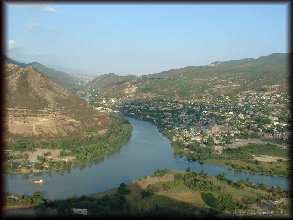 Georgi
from Iveria came early to pick me up in a Mercedes from Nasi’s place, and
we sped towards the Georgian Military Highway (“GMH”). This is a
200 km road leading from Tbilisi to Vladikavkaz in the Autonomous Republic
of North Ossetia-Alania within the Russian Federation. The GMH as
a route has existed since time memorial, and have always been the main
route of invasion of steppe nomads from the Eurasian plains southwards
to the Caucasusian valleys and the settled farming civilisations of the
Middle East further south. The Romans built the Porta Caucasis (Caucasis
Gates) at the Darial Gorge, a narrow canyon at the northern end of the
GMH but this certainly didn’t stop the tribes from marching across the
Caucasus. In fact, the Ossetians just beyond the Darial Gorge in
North Ossetia-Alania and those south of the Caucasus range in the self-proclaimed
Republic of South Ossetia (whose autonomous region was abolished by Gamsahurdia)
claim to be descendants of the ancient Alan tribes that once stroke terror
across Eastern Europe and the Ukrainian plains. Almost exactly one
year ago, I stood on the ancient fortresses and cave cities of Crimea,
Ukraine, some of which were built by a branch of the Alan tribes, and a
sense of excitement overcame me as I sped towards a region where the living
descendants of these people flourish today.
Georgi
from Iveria came early to pick me up in a Mercedes from Nasi’s place, and
we sped towards the Georgian Military Highway (“GMH”). This is a
200 km road leading from Tbilisi to Vladikavkaz in the Autonomous Republic
of North Ossetia-Alania within the Russian Federation. The GMH as
a route has existed since time memorial, and have always been the main
route of invasion of steppe nomads from the Eurasian plains southwards
to the Caucasusian valleys and the settled farming civilisations of the
Middle East further south. The Romans built the Porta Caucasis (Caucasis
Gates) at the Darial Gorge, a narrow canyon at the northern end of the
GMH but this certainly didn’t stop the tribes from marching across the
Caucasus. In fact, the Ossetians just beyond the Darial Gorge in
North Ossetia-Alania and those south of the Caucasus range in the self-proclaimed
Republic of South Ossetia (whose autonomous region was abolished by Gamsahurdia)
claim to be descendants of the ancient Alan tribes that once stroke terror
across Eastern Europe and the Ukrainian plains. Almost exactly one
year ago, I stood on the ancient fortresses and cave cities of Crimea,
Ukraine, some of which were built by a branch of the Alan tribes, and a
sense of excitement overcame me as I sped towards a region where the living
descendants of these people flourish today.
During the coming day, Georgi was to drive me all the way up to the
Russian border, visiting ancient monuments and monasteries in between.
The GMH we see today was built in the 19th C by the Russians, to secure
their supply lines south of the Caucasus Mountains. As explained above,
this was also the old route of invasions. Watch towers had been built by
the ancients to signal the arrival of new invaders, the remnants of which
could still be seen every few kilometer or so. Not far from here, a replay
of ancient conflicts is continuing. Against all odds, the proud Chechens
are resisting the mighty Russians and their tanks and bombers. Will
there be a victor ? The timeless Georgian Military Highway has seen
it all.
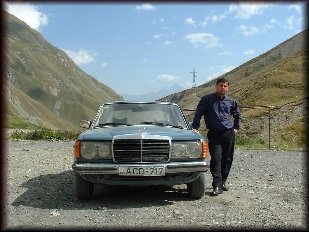 Georgi
& our car
Georgi
& our car
Within 20 minutes out of Tbilisi centre, we were almost at Mtskheta,
the old capital of Georgia and its most important religious centre.
Rising above this small town which stood at the confluence of the Agravi
and Mtkvari rivers was the Jvari Monastery built in the 6th C. Literally
meaning “Cross” monastery, this was where St Nino, a Cappadocian nun, erected
a cross upon bringing Christianity to Georgia. Jvari is small but
architecturally impressive with sharp clear lines and proportions.
Located on a lofty cliff, it offers us a magnificent view of Mtskheta.
We stopped by a restaurant to have kinkali, a kind of Georgian dumplings
which looks no different from those found in the northern plains of China.
Then we proceeded to visit Mtskheta’s Sveti-tskhoveli Cathedral, Georgia’s
holiest, their equivalent of St Peter’s of Rome. Sveti-tskhoveli
means “Life-Giving Pillar”. This was where Sidonia, sister of Elias,
a Georgian Jew, was buried. Elias had converted to Christianity while
in Jerusalem when Jesus was crucified, and brought back to Mtskheta Jesus’
robe. Sidonia came into contact with the holy robe and was so touched
by it that she died immediately. In fact, she held on so tightly
to the holy robe that the robe had to be buried together with her.
Thereupon a huge cedar grew from her grave. Three hundred years later,
King Miran of the Georgians went hunting in the forest and suddenly the
sky turned dark. He prayed to the pagan gods but to no avail.
Nino, the Cappadocian nun prayed to the Christian god and light was restored,
thereby convincing the king of the power of the Christian faith.
He converted together with his people and decided to build a church at
Sidonia’s grave. He had the cedar chopped down and cut into seven
pieces. Six were used to build the foundations of the cathedral and
the seven rose to the sky. It returned to the ground only after St
Nino and her nuns prayed all night. (Why should they bring it down
to the ground ? Just imagine a log floating in the sky – it would have
attracted many more tourists to Georgia today!) A sacred liquid then
flowed from it which cured all illnesses, and hence the place came to be
known as the life-giving pillar. This was an important event in Georgian
religious history and is commemorated in many icons around the country.
Next we sped along the Aragvi Valley, passing reservoirs, scenic villages,
quaint old churches and bashbushkas selling local produce. We passed
Ananuri, a fortress-monastery complex built by a local baron to extort
dues from passing traders. Overlooking the serene Zhinvali Reservoir,
this is a beautiful building still used as a church, and one can see an
ancient watch tower enclosed in the middle of the complex. We continued
northwards, upping our altitude. The road became narrower and rougher.
The collapse of the USSR has taken a toll on the maintenance of this important
highway. At times, it became no more than a muddy track. Occasional
hamlets and watch towers could be seen from afar. This is the real
Caucasus, land of impenetrable mountains and freedom-loving tribes.
Their descendants continue to travel along this highway…in the form of
timeless shepherds, as well as the mechanical machines we call cars.
Georgi was fond of identifying the ethnic badge of oncoming drivers – Ossete,
Chechensky, Grujinsky, Russky, Ingushsky, etc. Ossetian, Chechen, Georgian,
Russian, Ingush, as he pointed assorted tribes with great delight.
By 5pm, we reached Kazbegi, a little village near the Russian border.
The magnificent snowcapped Mt Kazbek rose high above the village.
The Church of the Holy Trinity sit on the summit of the lower peak of the
twin-peaked Kazbek – isn’t that the picture I have seen on countless postcards
? A holy mountain, the Georgians say, for this was where Amirani,
the Georgian Prometheus, was chained in a cave as a punishment for giving
mankind fire. Some say this was where Christ was buried, or even
the place where he was actually born… To the obscure shepherd clans who
still wonder in these mountains, this was the place of their pagan gods.
Even today, mountaineers often come across shrines with fresh ram heads
sacrificed to these ancient deities. Georgia may be the second Christian
state in the world, but old customs die hard in these remote corners.
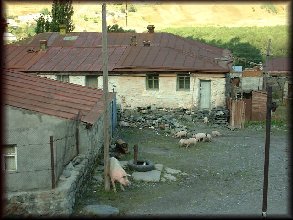 |
 |
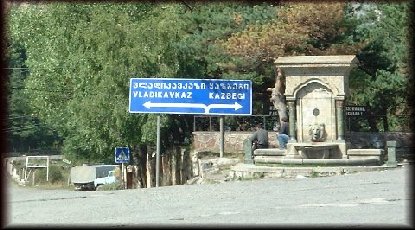 |
|
|
|
|
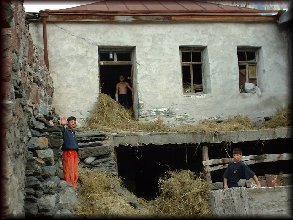 |
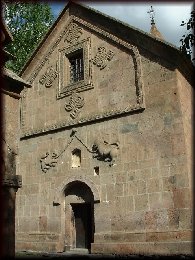 |
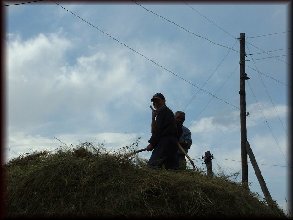 |
|
|
|
|
![]() 4
September Georgian Military Highway
4
September Georgian Military Highway
To the Russian Border